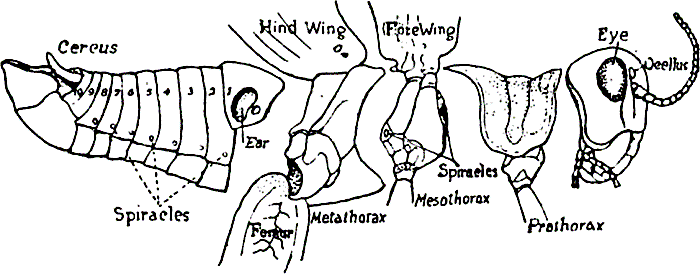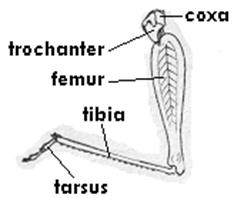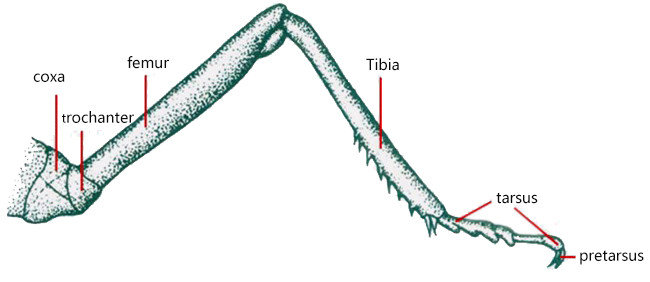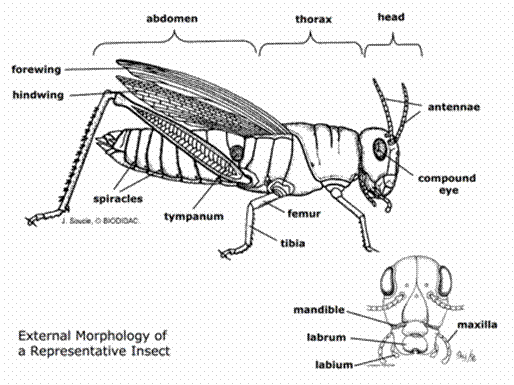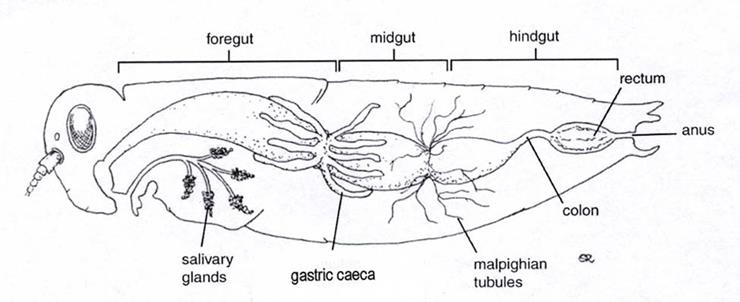Biology 2
Grasshopper Dissection Lab
If you missed the dissection lab, click HERE for a video that details the exact same dissection techniques that were done in class.
Introduction:
Insects are
arthropods with jointed appendages, segmented bodies, and an
exoskeleton composed of chitin.
Insects belong to the Class Insecta, and are the largest
and most diverse group of animals on earth.
The genus Romalea
is a large grasshopper common in the southeastern United States.
The common name for this grasshopper is the Eastern
Lubber Grasshopper.
The scientific name for this grasshopper is
Romalea guttata.
There are several other versions of this name (Romalea
micropetera), but this is the current and most acceptable
name. This is the
type of grasshopper you will be dissecting today.
Insects
have three body regions (head, abdomen, and thorax), 3 pairs of
legs attached to the thorax, a single pair of antenna attached
to the head, mouthparts adapted for chewing (like the
grasshopper) or sucking, and 2 pairs of wings.
Some insects may have a single pair of wings, while
others may be wingless.
The grasshopper has two pairs of wings.
Insect legs are often adapted for digging, crawling,
jumping, or swimming.
The insects are mostly terrestrial, they breathe air
which enters small lateral openings on the abdomen called
spiracles and circulates in a system of ducts to all organs and
tissues. Their
chewing or sucking mouth parts are adapted for feeding on plant
or animal materials.
Characteristics:
Grasshoppers
have the typical insect body plan of head, thorax and abdomen.
The head is held vertically at an angle to the body, with the
mouth at the bottom. The head bears a large pair of compound
eyes which give all-round vision, three simple eyes which can
detect light and dark, and a pair of thread-like antennae that
are sensitive to touch and smell. The downward-directed
mouthparts are modified for chewing and there are two sensory
palps in front of the jaws.
The thorax
and abdomen are segmented and have a rigid cuticle made up of
overlapping plates composed of chitin. The three fused thoracic
segments bear three pairs of legs and two pairs of wings. The
forewings, known as tegmina, are narrow and leathery while the
hindwings are large and membranous, the veins providing
strength. The legs are terminated by claws for gripping. The
hind leg is particularly powerful; the femur is robust and has
several ridges where different surfaces join and the inner
ridges bear stridulatory pegs in some species. The posterior
edge of the tibia bears a double row of spines and there are a
pair of articulated spurs near its lower end. The interior of
the thorax houses the muscles that control the wings and legs.
The abdomen
has ten segments, the first of which is fused to the thorax
and contains the tympanal organ and hearing system. Segments two
to eight are ring-shaped and joined by flexible membranes.
Segments nine and ten are reduced in size; segment nine bears a
pair of cerci and segment ten has the
reproductive organs. Female grasshoppers are normally larger
than males, with short ovipositors. The name of the suborder "Caelifera"
comes from the Latin and means chisel-bearing, referring to the
shape of the ovipositor.
Those
species that make easily heard noises usually do so by rubbing a
row of pegs on the hind legs against the edges of the forewings
(stridulation). These sounds are produced mainly by males to
attract females, though in some species the females also
stridulate.
Grasshoppers
may be confused with crickets, but they differ in many aspects;
these include the number of segments in their antennae and the
structure of the ovipositor, as well as the location of the
tympanal organ and the methods by which sound is produced.
Crickets have antennae that can be much longer than the body and
have at least 20–24 segments, while grasshoppers have fewer
segments in their shorter, stouter antennae.
Diet
and digestion
Most
grasshoppers are polyphagous, eating vegetation from multiple
plant sources, but some are omnivorous and also eat animal
tissue and animal feces. In general, their preference is for
grasses, including many cereals grown as crops. The digestive
system is typical of insects, with Malpighian tubules
discharging into the midgut. Carbohydrates are digested mainly
in the crop, while proteins are digested in the ceca of the
midgut. Saliva is abundant but largely free of enzymes, helping
to move food and Malpighian secretions along the gut. Some
grasshoppers possess cellulase, which by softening plant cell
walls makes plant cell contents accessible to other digestive
enzymes.
Sensory organs
Grasshoppers
have a typical insect nervous system and have an extensive set
of external sense organs. On the side of the head are a pair of
large compound eyes which give a broad field of vision and can
detect movement, shape, color and distance. There are also three
simple eyes (ocelli) on the forehead which can detect light
intensity, a pair of antennae containing olfactory (smell) and
touch receptors, and mouthparts containing gustatory (taste)
receptors. At the front end of the abdomen there is a pair of
tympanal organs for sound reception. There are numerous fine
hairs (setae) covering the whole body that act as
mechanoreceptors (touch and wind sensors), and these are most
dense on the antennae, the palps (part of the mouth), and on the
cerci at the tip of the abdomen. There are special receptors (campaniform
sensillae) embedded in the cuticle of the legs that sense
pressure and cuticle distortion. There are internal "chordotonal"
sense organs specialized to detect position and movement about
the joints of the exoskeleton. The receptors convey information
to the central nervous system through sensory neurons, and most
of these have their cell bodies located in the periphery near
the receptor site itself.
Circulation and respiration
Like other
insects, grasshoppers have an open circulatory system and their
body cavities are filled with hemolymph. A heart-like structure
in the upper part of the abdomen pumps the fluid to the head
from where it percolates past the tissues and organs on its way
back to the abdomen. This system circulates nutrients throughout
the body and carries metabolic wastes to be excreted into the
gut. Other functions of the hemolymph include wound healing,
heat transfer and the provision of hydrostatic pressure, but the
circulatory system is not involved in gaseous exchange.
Respiration is performed using tracheae, air-filled tubes, which
open at the surfaces of the thorax and abdomen through pairs of
valved spiracles. Larger insects may need to actively ventilate
their bodies by opening some spiracles while others remain
closed, using abdominal muscles to expand and contract the body
and pump air through the system.
Jumping:
A large
grasshopper, such as a locust, can jump about a meter (twenty
body lengths) without using its wings; the acceleration peaks at
about 20 g. Grasshoppers jump by extending their large back legs
and pushing against the substrate (the ground, a twig, a blade
of grass or whatever else they are standing on); the reaction
force propels them into the air. They jump for several reasons;
to escape from a predator, to launch themselves into flight, or
simply to move from place to place. For the escape jump in
particular there is strong selective pressure to maximize
take-off velocity, since this determines the range. This means
that the legs must thrust against the ground with both high
force and a high velocity of movement. A fundamental property of
muscle is that it cannot contract with high force and high
velocity at the same time. Grasshoppers overcome this by using a
catapult mechanism to amplify the mechanical power produced by
their muscles.
The jump is
a three-stage process. First, the grasshopper fully flexes the
lower part of the leg (tibia) against the upper part (femur) by
activating the flexor tibiae muscle (the back legs of the
grasshopper in the top photograph are in this preparatory
position). Second, there is a period of co-contraction in which
force builds up in the large, pennate extensor tibiae muscle,
but the tibia is kept flexed by the simultaneous contraction of
the flexor tibiae muscle. The extensor muscle is much stronger
than the flexor muscle, but the latter is aided by
specializations in the joint that give it a large effective
mechanical advantage over the former when the tibia is fully
flexed. Co-contraction can last for up to half a second, and
during this period the extensor muscle shortens and stores
elastic strain energy by distorting stiff cuticular structures
in the leg. The
extensor muscle contraction is quite slow (almost isometric),
which allows it to develop high force (up to 14 N in the desert
locust), but because it is slow only low power is needed. The
third stage of the jump is the trigger relaxation of the flexor
muscle, which releases the tibia from the flexed position. The
subsequent rapid tibial extension is driven mainly by the
relaxation of the elastic structures, rather than by further
shortening of the extensor muscle. In this way the stiff cuticle
acts like the elastic of a catapult, or the bow of a
bow-and-arrow. Energy is put into the store at low power by slow
but strong muscle contraction and retrieved from the store at
high power by rapid relaxation of the mechanical elastic
structures.
Stridulation
Male
grasshoppers spend much of the day stridulating, singing more
actively under optimal conditions and being more subdued when
conditions are adverse; females also stridulate, but their
efforts are insignificant when compared to the males. Late-stage
male nymphs can sometimes be seen making stridulatory movements,
although they lack the equipment to make sounds, demonstrating
the importance of this behavioral trait. The songs are a means
of communication; the male stridulation seems to express
reproductive maturity, the desire for social cohesion and
individual well-being. Social cohesion becomes necessary among
grasshoppers because of their ability to jump or fly large
distances, and the song can serve to limit dispersal and guide
others to favorable habitat. The generalized song can vary in
phraseology and intensity and is modified in the presence of a
rival male, and changes again to a courtship song when a female
is nearby. In male grasshoppers of the family Pneumoridae, the
enlarged abdomen amplifies stridulation.
Life
cycle
In most
grasshopper species, conflicts between males over females rarely
escalate beyond ritualistic displays. Some exceptions include
the chameleon grasshopper (Kosciuscola tristis), where males may
fight on top of ovipositing females, engaging in leg grappling,
biting, kicking and mounting.
The newly
emerged female grasshopper has a preoviposition period of a week
or two while she increases in weight and her eggs mature. After
mating, the female of most species digs a hole with her
ovipositor and lays a batch of eggs in a pod in the ground near
food plants, generally in the summer. After laying the eggs, she
covers the hole with soil and litter. Some, like the
semi-aquatic Cornops aquaticum, deposit the pod directly into
plant tissue. The eggs in the pod are glued together with a
froth in some species. After a few weeks of development, the
eggs of most species in temperate climates go into diapause and
pass the winter in this state. Diapause is broken by a
sufficiently low ground temperature, with development resuming
as soon as the ground warms above a certain threshold
temperature. The embryos in a pod generally all hatch out within
a few minutes of each other. They soon shed their membranes and
their exoskeletons harden. These first instar nymphs can then
jump away from predators.
Grasshoppers
undergo incomplete metamorphosis: they repeatedly molt, each
instar becoming larger and more like an adult, with the
wing-buds increasing in size at each stage. The number of
instars varies between species but is often six. After the final
molt, the wings are inflated and become fully functional. The
migratory grasshopper, Melanoplus sanguinipes, spends about 25
to 30 days as a nymph, depending on sex and temperature, and
lives for about 51 days as an adult.
Anti-predator defenses
Grasshoppers exemplify a range of anti-predator adaptations,
enabling them to avoid detection, to escape if detected, and in
some cases to avoid being eaten if captured. Grasshoppers are
often camouflaged to avoid detection by predators that hunt by
sight; some species can change their coloration to suit their
surroundings.
Several species such as the hooded leaf grasshopper Phyllochoreia ramakrishnai (Eumastacoidea) are detailed mimics of leaves. Stick grasshoppers (Proscopiidae) mimic wooden sticks in form and coloration. Grasshoppers often have deimatic patterns on their wings, giving a sudden flash of bright colors that may startle predators long enough to give time to escape in a combination of jump and flight.
Some species are genuinely aposematic, having both bright
warning coloration and sufficient toxicity to dissuade
predators. Dictyophorus productus (Pyrgomorphidae) is a "heavy,
bloated, sluggish insect" that makes no attempt to hide; it has
a bright red abdomen. A Cercopithecus monkey that ate other
grasshoppers refused to eat the species. Another species, the
rainbow or painted grasshopper of Arizona, Dactylotum bicolor (Acridoidea),
has been shown by experiment with a natural predator, the little
striped whiptail lizard, to be aposematic.
Eastern Lubber Grasshopper Phylogeny:
Kingdom =
Animalia
Phylum =
Arthropoda
Class =
Insecta
Order =
Orthoptera
Family =
Romaleidae
Genus =
Romalea
Species = guttata
Dissection Lab Objectives:
1.
Identify and label the external anatomical structures of the
common grasshopper.
2.
Identify and label the internal anatomical structures of the
common grasshopper.
Materials Needed:
1.
dissection tray
2.
dissection tools (small scissors, tweezers, probes, scalpel)
3.
about 10 T-pins
4.
preserved grasshopper
Dissection Procedure Part One:
The External Anatomy
1.
Obtain a preserved grasshopper and rinse off any preservative
residue with water.
Place grasshopper in the dissecting tray.
2.
Observe that the body is divided into three regions:
Head, Thorax, and Abdomen.
Carefully observe where each region begins and ends.
3.
Use the diagram below to help you identify the basic external
features of the grasshopper.
Try to locate each item on your grasshopper that is
listed below.
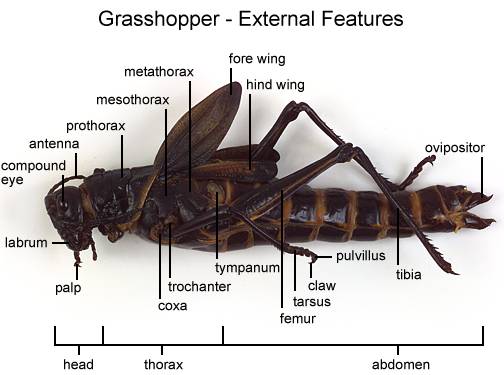
4.
Use the diagrams below and on the next page to help you locate
the structures found on the head of your grasshopper.
Try to identify each item on your grasshopper that is
shown below in the diagrams.
|
|
|

|
1. Labrum |
4. Labium |
|
2. Mandibles |
5. Maxillary
Palps |
|
3. Labial Palps |
6. Maxillae |
|
7. compound eye |
8. ocelli |
|
|
|


